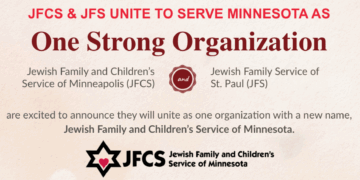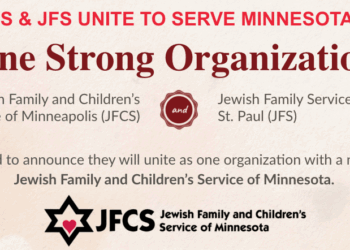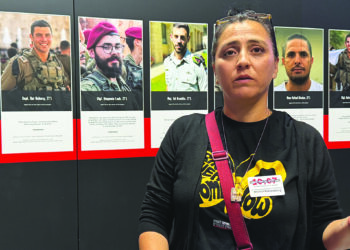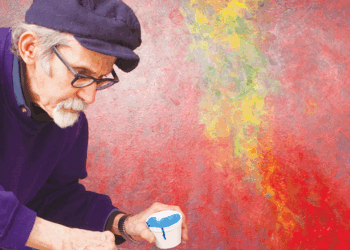By MORDECAI SPECKTOR
During an exchange of business cards during a recent meeting at Oak Ridge Country Club in Hopkins, Michael Siegal handed me two of his cards. One identifies him as the chairman of the board of governors of the Jewish Agency for Israel (JAFI).
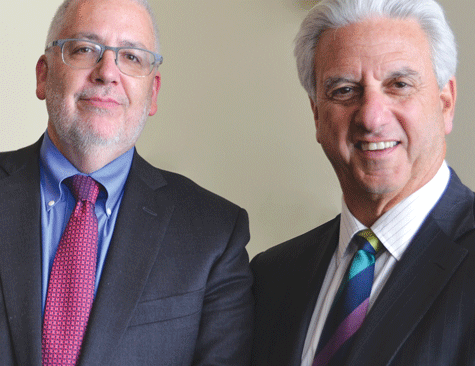
The other card is for Olympic Steel, an Ohio-based firm that happens to have two fabrication and distribution facilities in Plymouth, Minn. Siegal is the company’s chairman and CEO. However, the April 18 meeting concerned his role with JAFI, and his recent ascension to the organization’s board chair role.
Siegal, a Cleveland native, was accompanied to the meeting at Oak Ridge by Joshua Fogelson, former CEO of the Minneapolis Jewish Federation, from 1999 to 2010, and current CEO of international development for the Jewish Agency, which, according to his bio, directs the group’s “global financial resource development efforts.” Fogelson has been living in New York City for the past two years.
The meeting with the Jewish World was facilitated by Mort Naiman, who ran the Minneapolis Jewish Federation’s fundraising campaign for 17 years and now works for Fogelson, as senior vice president of the Jewish Agency’s Israel and global philanthropy.
Naiman noted that Siegal and Fogelson stopped in the Twin Cities, as part of a small tour, to meet with communal activists, and to thank local Jewish philanthropists for their gifts that support the activities of the Jewish Agency.
Specifically, Siegal and Fogelson met with the Minneapolis Jewish Federation’s Israel and overseas allocations committee, and the P2G (Partnership Together) committee, which concerns the local partnership with the Israeli city of Rehovot, according to Naiman. There also was a meeting with some members of the Minnesota Rabbinical Association (MRA), the umbrella group of Reform and Conservative rabbis. A reception with the Federation board was scheduled for later in the day.
The JAFI officials also met here with the families of “Lone Soldiers”; there are at least two young Minnesota Jews serving in the Israel Defense Forces. (Their stories likely would be of great interest to Jewish World readers.) Naiman pointed out that the Jewish Agency tends to the needs of all Lone Soldiers in Israel (about 2,000 in an average year), and aids in their transition back to civilian life in the Jewish state.
According to a 2016 income statement, JAFI had revenues of $449 million, which were spent on Israel experiences; aliya and absorption; activities with Russian-speaking Jews; sending Israel emissaries (shlichim) to diaspora communities; and varied other social programs and activities.
Jewish Federations send the bulk of their foreign allocations to the Jewish Agency, and to the American Jewish Joint Distribution Committee (JDC or “the Joint”), the international relief arm of North American Jewish community.
The Minneapolis Jewish Federation, for example, allocates about $1.2 million annually to the Jewish Agency, according to Naiman.
“About a million of that is core, unrestricted funding, which the agency is able to leverage in many different ways,” Fogelson explained. “And in addition, they fund some specific programs — two actually; one in Israel, which is called Youth Teachers, a mentorship program for vulnerable kids; and they also support our program of camps in the former Soviet Union,” which are designed to reconnect young Russian-speaking Jews with Jewish heritage and community life that was suppressed during the Soviet regime.
Siegal sketched out the missions — the “four pillars” — of the Jewish Agency.
“One, as Joshua just indicated, is to work with vulnerable parts of society,” said Siegal, adding that the first pillar is an “outgrowth” of the second pillar: immigration and absorption in Israel, aliya.
This is a “core competency” of the Jewish Agency. “We’re still doing aliya every single year,” commented Siegal. “Some years it’s 20,000 [immigrants to Israel], some years it might be 150,000. The obvious big movements that we know — the Moroccans, the Russians, the Ethiopians and others — we have a big expertise in bringing those populations in.”
Siegal referred to the “paint drying years,” the troughs in aliya, when there still are 20,000 immigrants coming to settle in Israel. The Jewish Agency specializes in the absorption of immigrants, and Siegal noted that “not everybody comes to Israel under the same conditions. Some of them come from very poor societies, or they come in at 80 years old.” JAFI tries to ensure that “vulnerable parts of the population have a chance to make it in Israeli society.”
A third pillar is the Jewish Agency’s effort to maintain a “vibrant connection between Israeli Jews and diaspora Jews, and we do that by crossing the oceans in all directions.”
The Jewish Agency sponsors the shlichim “to various communities, or day schools, or JCCs, or temples.” A young shaliach(Israel emissary) can reside in a Jewish community for “a short stint or for a couple of years.” This cultural exchange goes in both directions: shlichim are examples of everyday Israeliness for diaspora Jews, and then they bring back what they’ve experienced of our Jewish communities and pluralistic society to Israel.
The fourth pillar consists of programs for young diaspora Jews in Israel. “The Jewish Agency is heavily involved in three programs,” said Siegal, the most notable being MASA, a year-long education program, which is a joint venture between JAFI and the Israeli government.
Another well-known, short-term program is Birthright Israel, the free 10-day Israel trip for Diaspora Jews. And there is a college summer program called Onward, which Siegal described as a “résumé-building short-term program,” which fills the gap between Birthright and MASA.
For all of the Jewish Agency’s efforts to strengthen the bonds between Jews in the Diaspora and Israel, certain demographic trends are working against this relationship.
For example, the organized Jewish community in the United States more or less flipped out over the finding in a 2013 Pew Research Center survey, “A Portrait of Jewish Americans,” that nonreligious Jews felt that “having a good sense of humor” was more essential to their Jewish identity than was “caring about Israel” (40 percent to 23 percent).
In fact, many young, idealistic American Jews are discomfited by Israeli’s long-running military occupation of the Palestinian Territories and the recent shooting of Palestinian protesters on the border with Gaza.
For his part, Siegal emphasized that “the Jewish Agency is intimately involved in the issues around conversion and pluralistic prayer at the [Western] Wall.” Natan Sharansky, the professional leader of the Jewish Agency, has been involved in trying to negotiate a solution to prayer at the Western Wall, an issue that has roiled the liberal streams of American Judaism.
Naiman pointed out that Sharansky, after nine years, will soon leave his post with the Jewish Agency. Siegel and a nominating committee will be choosing Sharansky’s replacement.
Getting back to the issue of Jewish disaffection vis-à-vis Israel, Siegal cited his decades of Jewish communal activism and said, “The same issues are being debated now that were debated 30-some years ago. Where’s the next generation going and where are they coming from? Certainly, we have demographic challenges today, by a low secular birth rate and a high Orthodox birth rate. That’s going to change the nature of the Jewish community going forward.”
There’s a tendency to look at the “diminishing connection” of American Jews to Israel, without considering the “Orthodox aspect of their connection to Israel,” according to Siegel, who frames the issue as “a numbers game.”
“We have more kids that have gone to Jewish day school, we have more kids that have gone to Israel, we have more kids that have ever attended Jewish camp in the history of the Jewish people,” said Siegal. “I don’t know how people take that data and say we have less connection to Judaism and Israel. The reality is there’s a political narrative that says, ‘I can’t agree with the Netanyahu government’ or ‘I can’t agree with the left government.’ The answer is, we try and separate the noise out. There is no question we have less Jews in the non-Orthodox world… we’re not replacing ourselves.”
Fewer Jews means decreased support for Israel.
“That’s not good for Israel,” Siegal allowed. “But in the overall narrative over the last 20 years, and you look at the amount of money that the system has put into young connectivity to Judaism and Israel, we’ve got tremendous outcomes of more people than ever who have connected to Israel, in spite of the fact that we now say that less people are connected to Israel.”
(American Jewish World, 5.4.18)

